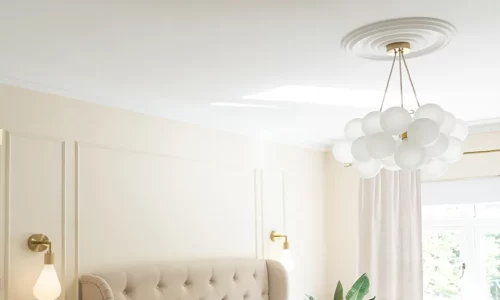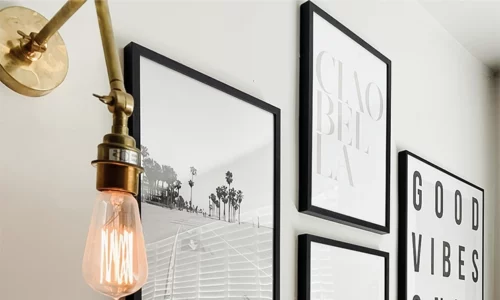A Light on Neurodiversity
Quick SummaryNeurodiversity experts share tips on how to create a neurodivergent-friendly home through lighting, particularly for children

Neurodiversity and Lighting a Home
Did you know that 70% of all the sensory receptors in our bodies are in our eyes?
Lighting has a huge impact on our lives – especially for those with neurodiversity. Poor lighting can lead to sensory dysregulation, increased anxiety and frustration, mood changes and at the extreme end, may manifest physically through frustration or anger.
In line with Neurodiversity Celebration Week, we’ve consulted various neurodiversity experts, who have shared their tips on how to create a more neurodivergent-friendly lighting scheme and the best lights for neurodiverse individuals in the home to help improve the lives of both parents and children.
What is Neurodiversity?
The Oxford Dictionary refers to neurodiversity as “the range of differences in individual brain function and behavioural traits, regarded as part of normal variation in the human population”.
What will I learn?
The best lighting in the home for neurodiverse children and adults.
The telltale signs that a neurodivergent child is struggling due to external factors like lighting, as well as expert tips on how to create a neurodivergent-friendly lighting scheme at home.
The experts also share their advice for how to promote wellbeing and relaxation, even after a day at school where the lighting may have been too bright and overstimulating.
Navigation
- Neurodiversity and Lighting a Home
- How Does Poor Lighting Affect Neurodivergent Children?
- Signs Your Child is Being Triggered by Bad Lighting
- Key triggers and what to avoid in the home
- How to help your neurodivergent child feel happy and safe at home through lighting
- A spotlight on lighting for:
- How to Use Lighting to Promote Calm After a Day at School
- Key Advice For Parents
- Final Thoughts
- Footnotes: About The Experts
How Does Poor Lighting Affect Neurodivergent Children?
Dr Becky Spellman: “Inadequate lighting can lead to sensory overload, increased anxiety, difficulties with concentration, and disruptions in sleep patterns for neurodivergent individuals.
“Prolonged exposure to unsuitable lighting can exacerbate these issues, leading to heightened stress levels and overall discomfort, affecting children’s mental and emotional health.”
Dr Patricia Britto: “In my experience, neurodivergent children and young people with sensory sensitivity to poor lighting have difficulties with focusing on tasks, reduced ability to remain seated, restlessness, impulsivity, and agitation which can trigger feelings of frustration and anger. This can trigger visual fatigue, anxiety, low mood, dysregulated behaviours (e.g., agitation and a display of verbal and physical aggression) and feelings of wanting to be withdrawn.
“All of these negative feelings and outcomes can limit the neurodivergent ability to engage and function adequately in spaces (e.g., learning in a classroom) where there is poor lighting.”

Dr. Fleur-Michelle Coiffait: “in extreme instances, the individual can be triggered with a ‘fight or flight’ response.
“Appropriate lighting promotes focus, concentration, wellbeing, comfort, and overall functioning. It is essential to recognise the diverse sensory needs of neurodivergent individuals and create environments that are accessible, welcoming and inclusive.”
Helen Neale: “This said, It isn’t helpful to generalise the neurodivergent brain because every single profile within it is completely different, particularly within sensory environments. It’s important to listen to your child and respond to what they need on an individual basis.”
Signs Your Child is Being Triggered by Bad Lighting
When a neurodivergent individual finds an aspect of their environment challenging, they may respond in various ways depending on how they tend to express distress and overwhelm individual sensory processing differences. Dr Coiffait advises how to spot these telltale signs.
- Increased Movement
The individual may become more agitated, restless, or fidgety. They may show heightened physical movements or restlessness as a response to the aspects of the environment they are finding challenging.
- Anxiety or Panic
You may see signs of increased anxiety or panic, such as crying, curling into a ball or seeking comfort. Other more subtle signs of distress can include freezing, hiding, rapid breathing, shaking or trembling.
- Sensory Blocking
Individuals may seek to reduce sensory information coming in by covering their eyes or ears, closing their eyes, shouting, screaming, covering themselves up with something, curling into a ball or retreating into a small, protective space.
By trying to ‘block out’ they may provide their own competing or replacement sensory input, such as making loud noises themselves, or seeking out heavy touch, pressure or hugs.
It’s important to note that every individual is unique, and responses can vary widely.
Key triggers and what to avoid in the home

- Glare
Glare from harsh lighting can be particularly problematic for neurodivergent individuals and may cause discomfort and visual stress. This can lead to difficulties in focusing and processing information.
Glare can be minimised by using anti-glare coatings on screens and windows, choosing lighting fixtures that diffuse light (such as calming wall lights), and having adjustable blinds or curtains that can also help control natural light.
- Brightness
Overly bright lighting can be overwhelming for some, especially those with sensory sensitivities. It may contribute to feelings of discomfort, anxiety, or sensory overload.
Opting for adjustable lighting options, such as dimmer switches or lamps with variable brightness settings, can enable individual control over lighting in personal spaces and allow people to adjust brightness to suit their own preferences.
- Hue and colour temperature
Different colour temperatures and hues affect individuals differently. Neurodivergent people may be sensitive to specific colours, while others may find certain hues calming or distressing.
Experimenting with different colour temperatures can help individuals identify what works better for them and it can be helpful to choose lighting with warmer tones in spaces that multiple people use. Personalised lighting preferences do vary, so allowing individuals to choose their preferred lighting where possible is ideal.
- Fluorescent lighting
Fluorescent lights can flicker and the colour temperature may be uncomfortable for some individuals, leading to headaches, eye strain, and/or sensory discomfort.
Using alternative lighting sources such as warm LED lights, which are often more energy-efficient, means these can be adjusted to softer tones.
- Task lighting
Insufficient or uneven lighting can affect concentration and task performance, especially for those with attention-related conditions.
Providing adequate task lighting that is adjustable and focused for specific activities, such as reading, writing, or working on a computer, can help individuals maintain focus and reduce eye strain. Natural lighting can also be a good option.
Whilst every neurodivergent child is different, Dr Coiffait points out these are triggers to be aware of.

How to help your neurodivergent child feel happy and safe at home through lighting
Creating a lighting environment that promotes happiness and a sense of safety for neurodivergent children involves considering their individual preferences and sensitivities. We all process sensory input differently and are all individual in what we like, prefer and what helps us, Dr Coiffait informs.
Dr Britto goes on to say “Many children and young people with neurodiversity see the home environment as a safe space where they can be their authentic selves and are less likely to feel the need to mask as they might in public spaces.
“Rooms with warm, muted-toned, soft and adjustable lighting allow neurodiverse people to feel more comfortable.”
Dr Coiffait gives her top tips on how to create an environment that makes a child feel happy, regulated and safe.
Soft, Warm Lighting:
Use soft and warm lighting with warm colour temperatures, such as yellows and oranges. This type of lighting is often more soothing and can contribute to a cosy and comforting atmosphere.
Neale adds, “if someone’s sensory profile means they avoid white lights, be respectful of that; calmer, lower lights of different hues that they find helpful.”
Dimmable Lights:
Install dimmable lights to allow for flexibility in adjusting the brightness. Being able to control the intensity of light can be empowering for the child and can cater to their specific needs at different times.
This is often especially important for autistic individuals.
Neal further comments, “Anything that helps neurodivergent people have more control of the environment would be amazing. It is, after all, the environment that is disabling rather than the neurodivergent brain.”
Personalised Lighting Choices:
Involve the child in choosing their preferred lighting options. This could include letting them pick the colour temperature, selecting decorative lighting fixtures, or even having the ability to control their own lighting settings.
Colourful and Decorative Lighting:
Integrate colourful and decorative lighting elements, such as fairy lights, bubble lights, or colour-changing lamps. These can add a playful and visually appealing touch to the child’s environment.
Natural Light Exposure:
Maximise exposure to natural light during the day. Arrange furniture to allow more natural light into the room, and use curtains or blinds that can be adjusted to control the amount of light and glare.
Visual Cues for Transitions:
Use lighting as a visual cue for transitions between activities. For example, a specific colour of light could indicate playtime, while a different colour could signal quiet reading time.
Sensory Lighting Options:
Explore sensory lighting options, such as light projectors that create soothing patterns on the walls or ceiling. These can be particularly engaging and calming for some neurodivergent children
Thinking about each person’s lighting needs for specific tasks is important.

Incorporate Personalised Night Lights in the Bedroom :
If the child has a favourite character or theme, consider incorporating personalised bedroom lighting such as night lights or bedside lamps that align with their interests or that are in the shape of their initials. This can make the space feel more personalised and comforting.
“It might be worth investing in SAD lights, which can be beneficial for sleep problems,” Neale comments. Dr Spellman adds to this, “diffused lighting to reduce glare, task-specific lamps for focused activities, natural light for mood enhancement, calming colours, and sufficient contrast for visibility” are all great ways to design a child’s room.
A spotlight on lighting for:
ADHD / ADD
Neale: “”It is all about reducing distractions, so lights that hum and flicker can cause problems for ADHDers as they focus on that rather than what they want to focus on. A calm, quiet and steady lighting environment might be beneficial.”
Dr Spellman: “ADD/ADHD: Individuals with ADD/ADHD may have difficulties with attention and focus, and lighting that is too bright or distracting can make it challenging for them to concentrate.
“Recommendations for individuals with ADD/ADHD include using soft, diffused lighting, minimising visual clutter in the environment, and adding in natural elements such as plants or views of nature to promote calmness and focus.”
Autism
Neale: “the autistic brain can kick in the fight, flight or freeze if it becomes overwhelmed. If we get the environment right so it isn’t disabling then our kids are in the right place so they can learn, or we are able to work and concentrate.
“It is often the environment that disables the autistic brain, so with the lighting right, and other sensory needs met, that wonderful creativity within can shine through.
“The most important is adjustable lighting so that autistic people feel in control of their environment and can match their sensory needs that can sometimes change from hour to hour, it depends on how overwhelmed their senses get.
“It might be that they benefit from coloured lights and/or filters too, as some autistic people can find certain colours soothing.”
Dyslexia/Dysgraphia
Dr Spellman: “Individuals with dyslexia may struggle with reading and processing written information, and harsh lighting or glare can exacerbate these difficulties.
“They should try soft, diffused overhead lighting to reduce glare, avoiding overhead fluorescent lighting, and ensuring that the lighting is consistent throughout the space to minimise distractions.”
Dyspraxia
Dr Spellman: “People with dyspraxia often have difficulties with coordination and spatial awareness, and bright or flickering lights can be overwhelming for them.
“They should use warm, soothing lighting, with brighter lighting for focused activities, whilst minimising clutter and visual distractions.”
Neale: “If there is a specific activity within a room, have a light focused on this.”
Dyscalculia
Dr Spellman: “Individuals with dyscalculia struggle with mathematical concepts and processing numbers, and lighting that is too bright or harsh can make it challenging for them to concentrate on numerical tasks.
“They should use neutral or warm lighting, providing task-specific lighting for numerical activities, and ensuring that the lighting is consistent and even throughout the space.”
Dysgraphia
Dr Spellman: “People with dysgraphia have difficulties with writing and fine motor skills, and lighting that is too bright or dim can affect their ability to see and produce written work.
“They should use adjustable lighting options, providing ample natural light when possible, and using brighter lighting for writing activities.”

How to Use Lighting to Promote Calm After a Day at School
Neale: “This is entirely dependent on the child – they might need a quiet, darker space at home if they have been exposed to the bright lights of school.
“Sometimes our children are just “done” by the time they get home after the demands of school, and they need a safe space to be where they have no demands on them, where their senses aren’t overloaded, and they just have time to be quiet.”
Dr Britto: “Children and young people with neurodiverse needs often benefit from accessing a room with soft coloured tones and calm lighting after a day coping with the sensory demands of school or being in an environment that is not neurodiversity-affirming.”
Dr Spellman: “Soft, dim lighting in calming colours can help settle neurodivergent children after a hectic day at school. Creating a cosy, soothing environment with gentle lighting can reduce sensory overload, help them to relax, and support their transition from a busy day to a peaceful evening.”
Dr Coiffait: “All children will have different preferences, but spending time outside in natural light wherever possible is generally helpful for regulating children’s sleep/wake cycles and circadian rhythms, and children often benefit from time outside and fresh air after a hectic day at school as a way of unwinding and destressing.”
Neale: “It is important not to think about visuals in isolation though. Auditory processing plays a big part within a school environment, as well as the demands that are placed on them within the school day.”
“All of this has an effect on our neurodivergent brains, and it’s why we need to get to know our individual child.”
Key Advice For Parents
- Routine and predictability
Dr Coiffait: “Many neurodivergent individuals thrive on routine and predictability, becoming particularly important and grounding when they are overwhelmed or dysregulated. Routines and predictable and familiar activities or sequences can be calming, soothing and regulating for neurodivergent individuals.
“Using visual cues or timers to signal changes in lighting, can also help people understand why lighting might need to change and vary in the same space”
- Create a bedtime lighting routine
Dowsing Reynolds: “Plenty of research now shows that what time we go to bed impacts us massively – the earlier before midnight the better and the more consistent the better.
“We have to take care of our circadian rhythms… especially when we are neurodiverse.
“Have warm light sources in the place where you are during evening (so maybe the table and floor lamps in your living room and bedroom) – you want a low colour temperature (around 2700k) to reduce blue light exposure which can interfere with the sleep hormone melatonin.
Lamps with shaded or frosted glass can also help a room to feel much more relaxing at night.”
- …and also create a morning lighting strategy
“I have a Philips Lumie lamp that gradually wakes me up in the morning. It simulates the sunrise for a more natural wake up. I am pretty sure you can also get them to do the opposite, mimic the setting sun.”
Final Thoughts
“It is critical to invest in the correct lighting design for spaces where neurodiverse children have access to ensure they feel secure, safe, and regulated”, Dr Britto says in summary. Ally Dowsing-Reynolds recommends trying to “avoid lighting setups that create harsh contrasts, excessive brightness, or use overly vibrant colours that can lead to sensory overload.”
However, Dr Coiffait advises parents to bear in mind that the sensory experiences of neurodivergent individuals will be unique and specific to each person. For example, while one child may be particularly sensitive to bright lights, another may enjoy colourful or flashing lights because they find them engaging.
A full assessment by a qualified Occupational Therapist (in the UK they should be registered with the Health and Care Professions’ Council, the HCPC) who has completed additional training in Sensory Integration can inform this and provide tailored recommendations.And finally: “Remember that communication with the child is crucial. Ask for their input, observe their reactions to different lighting conditions, and be open to making adjustments based on their preferences”, says Dr Coiffait. “Creating a happy and safe lighting environment involves tailoring the lighting setup to meet the specific needs and sensory preferences of the child.”
Footnotes: About The Experts
- Ally Dowsing Reynolds
About Ally: Ally Dowsing-Reynolds is co-founder of Leeds-based home décor brand and retailer Dowsing & Reynolds. Immersed in the world of home interiors, Ally understands just how much our homes impact our lives.
She loves to share her expert knowledge, tips and tricks for creating a space that not only looks good, but feels good too – somewhere that reflects your unique personality. Having talked on-stage at some of the biggest home shows, along with regularly appearing in leading interior magazines, Ally’s passion for exceptional design (particularly fixtures and fittings) is infectious.
Being neurodiverse, Ally also loves to explore how specific changes can create a more inspiring space whilst making it work for your brain’s unique wiring – a topic she’s spoken widely about in her three-part column for Real Homes.
- Helen Neale
About Helen: Helen Neale is a counsellor and editor of kiddycharts.com, as well as an ADHDer, and parent to neurodivergent children. She is passionate about supporting both adults and children with positive wellbeing, and her site reflects this. As a former librarian, she has combined both callings to launch, with a UK book publisher (Quarto Kids), a free wellbeing book club to kids globally called the Shelf Care Club. KiddyCharts has been providing help to parents, families, teachers, and homeschoolers for over ten years, and firmly believes that every child has a right to the support needed to enable them to reach their full potential.
- Dr. Patricia Britto
About Patricia: Dr. Patricia Britto is a qualified Educational Psychologist (HCPC Registered) and a mother with practical and research experience. Her qualifications include a Doctorate in Professional Educational, Child and Adolescent Psychology (DEdPsy) from UCL, Institute of Education, an MSc in Mental Health in Learning Disabilities and a BSc in Psychology. Dr Patricia works Independently at the prestigious Harley Street and within Local Authorities Educational Psychology Services to promote children and young people’s (age 0-25) learning and social, emotional and mental well-being. Dr. Patricia offers families, communities, and educational settings support through consultation, individual psychological assessments suitable for children and young people, and systemic work (e.g., training, workshops and organisational psychology support).
- Dr. Becky Spellman
About Becky: Dr Becky Spellman is a London-based Counselling Psychologist who uses Psychodynamic Therapy, Cognitive Behavioural Therapy (CBT), Eye Movement Desensitisation Reprocessing, Dialectical Behaviour Therapy (DBT) and Mindfulness to treat a range of difficulties. She has appeared a number of times in the media treating phobias, sleep disorders and other conditions.
Accreditation: Health & Care Professions Council (HCPC), Registered Practitioner Psychologist & British Association for Behavioural and Cognitive Psychotherapies (BABCP), British Psychological Society (BPS)
- Dr. Fleur-Michelle Coiffait
About Fleur: Dr Fleur Coffair is a neurodivergent herself, mum to a neurodivergent daughter and Clinical Lead for Neurodiversity at Spectrum.Life. She is a Consultant Clinical Psychologist and Associate Fellow of the British Psychological Society and has 20 years of experience in working with neurodivergent individuals across a range of clinical, educational and organisational contexts. Fleur is committed to a neuroaffirmative approach and this has shaped Spectrum.Life’s new offer of digital multidisciplinary assessment, identification and support for neurodivergent individuals, focusing initially on autism and ADHD.
Note: This campaign was carried out in March 2024.




